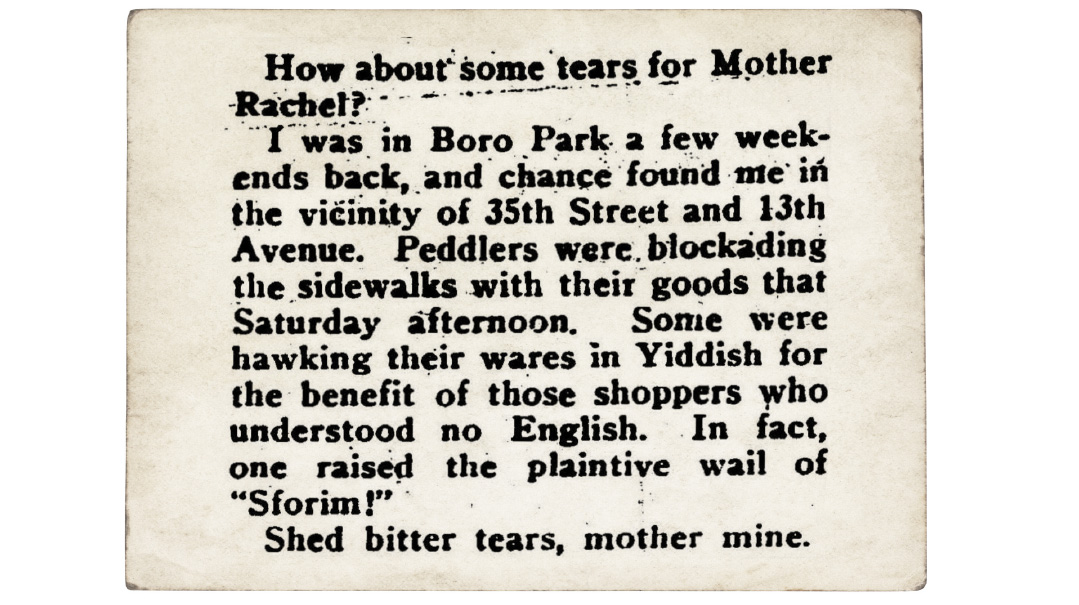Mama Rochel Cries for Boro Park
| October 18, 2022Boro Park is, indeed, as fine a representation of an American-Jewish community as you can find on these shores

Title: Mama Rochel Cries for Boro Park
Location: Boro Park, Brooklyn
Document: Der Tog
Time: 1936
Off the BQE there’s a place called Boro Park, where you can never park on 13th Avenue.
—Country Yossi
AS WAVES OF JEWISH IMMIGRANTS poured into the United States, New York City absorbed the overwhelming majority of the huddled masses seeking a new life. In the 40 years between 1880 and 1920, the city’s Jewish population exploded from 80,000 to over 1.5 million, making it the largest in history. While many later immigrants settled on the Lower East Side of Manhattan or Williamsburg in Brooklyn, earlier arrivals and second-generation Jews sought better lives in less-crowded neighborhoods. From the Bronx’s Grand Concourse to various Brooklyn neighborhoods, a Jewish middle class was emerging from the working-class first generation of immigrants.
Boro Park was one such neighborhood. Back then it was a suburban destination that offered residents abundant open space, farmland, and parks completely unavailable in the densely populated Lower East Side. During the first decade of the 20th century, Boro Park spawned such Orthodox synagogues as Temple Beth-El in 1902 and Shomrei Emunah in 1907, and the Conservative Temple Emanuel in 1908. Additional Jewish infrastructure soon followed in the form of the Hebrew Institute of Boro Park (known to posterity as Yeshiva Eitz Chaim), founded in 1916; the Israel Zion Hospital, later Maimonides; Shulamith School for Girls, and many others.
Concerned residents began to notice that traditional Jewish observance was on the decline. To combat the growing laxity, a group of laymen banded together to found Congregation Shomrei Shabbos in around 1918. Every individual applying for membership was scrutinized by the board to ascertain if he was indeed 100 percent shomer Shabbos.
The first chassidish rebbe to reside in Boro Park was likely Rav Itzik’l Halberstam of Bardiyov in 1923, though it wasn’t until the 1960s that Boro Park’s chassidic identity was crystallized with the arrival of the Bobover Rebbe, Rav Shlomo Halberstam, in 1966.
Soon 13th Avenue was lined with pushcart vendors hawking wares ranging from pickles to haberdashery. Street-side commerce was active on Shabbos as well, and this was a cause for concern for the future of the neighborhood’s religious character. With Yiddish-speaking pushcart vendors discussing the sale of seforim with potential customers on Shabbos afternoons, Jewish culture seemed to be flourishing in an ever-increasing absence of Jewish observance.
Yet less than two decades later, Dr. Joe Kamenetsky described a renaissance of Jewish life in the neighborhood in a 1953 article:
Perhaps in no other community in America have I seen the major Orthodox synagogues getting together on a common project. The “Joint Friday Night Forums,” sponsored by the four major synagogues — Shomrei Emunah, the Sephardishe Shul, Young Israel, and Temple Beth-El — are a tribute to the spirit of cooperation which permeates our Boro Park. The Young Israel of Boro Park is one of the few synagogues in the country which sponsors the “Daf Yomi.”
Most of the Jewish inhabitants of Boro Park have been in this country for many years. A large proportion of them were born here. All of the synagogues feature sermons or classes in English. The Jewish institutions sponsor ball games, picnics and card games. The fine ultra-modern dress shops, beauty parlors, and haberdasheries on 13th Avenue do a thriving business. Boro Park is, indeed, as fine a representation of an American-Jewish community as you can find on these shores.
A Boro Park Balabusta
Established in 1930, Shulamith School was the first Orthodox girls day school in the country. The dean of Hebrew studies for many years was Dr. Judith Lieberman. A daughter of Rav Meir Bar-Ilan, she grew up in the home of her paternal grandmother, Rebbetzin Basya Miriam, the widow of the Netziv, and later married Professor Saul Lieberman. Bais Yaakov of Boro Park opened with five students in 1942, and in 1958 Rebbetzin Vichna Kaplan opened a high school.
Yemen on 45th Street
In the late 1920s, Yemenite Jews escaping persecution immigrated to the United States. Initially settling on the Lower East Side, a large contingent soon moved to Boro Park, where they established the Ohel Shalom congregation. The Teimani community maintained its unique traditions within the new milieu of Boro Park, adding another flavor to the neighborhood’s Jewish mix.
In honor of Congregation Avi Ezri, whose members personify all the best traits of Boro Park’s rich history.
The authors can be contacted at fortherecord@mishpacha.com
(Originally featured in Mishpacha, Issue 932)
Oops! We could not locate your form.






